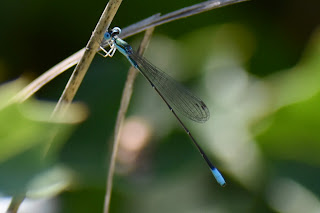Yesterday I took advantage of a break in humidity following yesterday’s rainstorms and ventured inland to Double Trouble State Park. The park’s physical address is in Bayville, NJ where the extinct Double Trouble Village is located. The defunct village once was a cranberry operation in the Pine Barrens, but it is now part of the 8,000-acre state park sprawled across the neighboring townships of Berkeley and Lacey.
My intent was to find the hooded warblers that summer there and the yellow-breasted chat that has returned for a second summer in three years. Neither species is a new bird for me, but I have not seen a hooded warbler yet this year, and I wanted a better photo of a chat. The known locations of the birds are near each other. I tried for the warblers first and, like the previous two attempts, did not see or hear one. I walked over to the large restoration area where the chat has been residing, but it too was neither heard nor seen. Upon returning from a walk deeper into the park’s expanse, I finally heard the chat.
Chats are more often heard than seen, and this one was no different. They are adept at skulking through brush but will perch conspicuously to sing. After waiting it out, I finally spotted it high on top of a snag in the middle of the field. I managed one identifiable photo before it flew back into cover. Even with my 70-300mm lens, it was still too distant for a quality shot.
Yellow-breasted chat. © S. Weiss
The chat was previously a member of the new world warbler group of birds, but in 2017 it was placed in its own family, icteriidae. This is different from the new world blackbird family, icteridae.
Between visits to the chat area, I took a walk to search for a rough green snake that my friend John found at the park last month. This species also eluded me today, although I did see a northern watersnake. Along the way, I did see and hear some other creatures, some that I even managed to photograph. A few that I didn’t get a photo of were an eastern painted turtle, a couple green frogs and bullfrogs. Insects were the most cooperative today, especially dragonflies and allies. Among the dragonfly type insects seen today were painted skimmer, great blue skimmer, blue dasher, calico pennant and sphagnum sprite. They are all native species.
Left, blue dasher. Right, great blue skimmer. © S. Weiss
Left, a delicate sphagnum sprite. Right, a calico pennant. © S. Weiss
Painted skimmer. © S. Weiss
The couple of butterflies that I could grab photos of were spicebush swallowtail, variegated fritillary, common buckeye and an azure species. I also found a caterpillar that my Seek app could only best identify as a sheepmoth genus. All of these are native to the area.
Left, variegated fritillary. Right, common buckeye. © S. Weiss
Left, spicebush swallowtail. Right, a tiny blue butterfly belonging to the azures. © S. Weiss
Caterpillar belonging to the genus of Sheepmoths. © S. Weiss
The other insects I saw were a large four-spotted scoliid wasp and a backswimmer. The large four-spotted scoliid wasp deposits its eggs on to beetles. The larvae will then feed off of its host. Seek could only narrow down the backswimmer to the genus milky backswimmers. They prefer still or stagnant water where they swim upside down.
Left, large four-spotted scoliid wasp. Right, a milky backswimmer. © S. Weiss
Left, northern highbush blueberry. Right, sweet-fern. © S. Weiss
Both plants are natives. The sweet-fern, however, is not actually a fern.
A Joe-Pye weed. © S. Weiss
Joe-Pye weed is a native flowering plant. It attracts bees, butterflies and seed-eating birds.
Northern watersnake. © S. Weiss
The northern watersnake is a common, native and non-venomous snake that will still bite to defend itself.




















Comments
Post a Comment